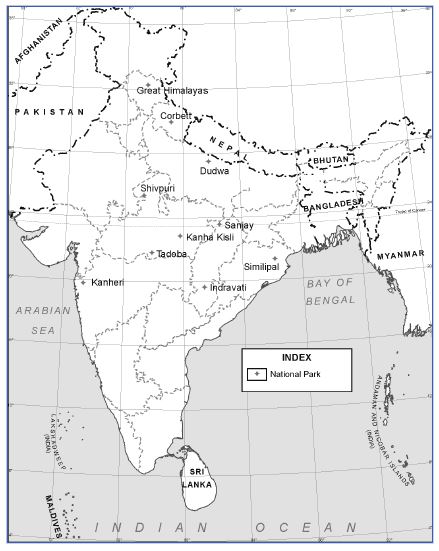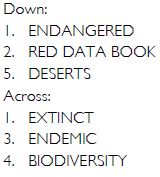Question 1:
A place where animals are protected in their natural habitat is called __________.
Answer:
Wildlife sanctuary
Question 2:
Species found only in a particular area are known as ___________.
Answer:
Endemic species
Question 3:
Migratory birds fly to far away places because of ___________ changes.
Answer:
Climatic
Question 4:
Differentiate between the following:
(a) Wildlife sanctuary and biosphere reserve
(b) Zoo and wildlife sanctuary
(c) Endangered and extinct species
(d) Flora and fauna
Answer:
Question 5:
Discuss the effect of deforestation on the following.
(a) Wild animals
(b) Environment
(c) Villages (Rural areas)
(d) Cities (Urban areas)
(e) Earth
(f) The next generation
Answer:
(a) Deforestation destroys the natural habitat of wild animals and thus, they can become endangered.
(b) Deforestation decreases the level of oxygen in the atmosphere. The rainfall and fertility of soil also decreases due to deforestation. As a result, there are increased chances of natural calamities like floods and drought.
(c) Most of the agriculture is done in rural areas. Deforestation leads to a change in soil properties, which in turn affects the agriculture.
(d) In cities there are many factories and automobiles. Deforestation further pollutes the environment and hence, the life in cities will not be healthy for living.
(e) Deforestation leads to an increase in the temperature of the earth causing global warming. Less trees would result in more soil erosion.
(f) Deforestation leads to climatic changes which has a great effect on the next generation. So, the next generation would not be as prosperous as the previous one.
Question 6:
What will happen if
(a) we go on cutting trees?
(b) the habitat of an animal is disturbed?
(c) the top layer of soil is exposed ?
Answer:
(a) If we go on cutting trees continuously, rainfall and fertility of the soil will decrease. Hence, there are increased chances of natural calamities such as floods and drought.
(b) If the habitat of an animal is disturbed, some of the species will not get appropriate food and shelter and with the passage of time they will come under the category of endangered species.
(c) If the top layer of the soil is exposed, the soil will have less humus and will become less fertile. Gradually, the land will convert into desert. This is called desertification.
Question 7:
Answer in brief
(a) Why should we conserve biodiversity?
(b) Protected forests are also not completely safe for wild animals. Why?
(c) Some tribals depend on the jungle. How?
(d) What are the causes and consequences of deforestation?
(e) What is a Red Data Book?
(f) What do you understand by the term migration?
Answer:
(a) We should conserve biodiversity to save flora and fauna from extinction.
(b) Protected forests are also not completely safe for wild animals because people living in the neighbourhood encroach upon them and harm them.
(c) Certain tribes depend on jungle for food, shelter and fuel.
(d) Human beings are the main cause of deforestation. Forests are cleared to use land for the cultivation of crops, construction of houses, roads, factories etc. Forest fire and drought are some natural causes of deforestation.
Deforestation has adverse affects on the food chains. Deforestation results in increased levels of carbon dioxide in the atmosphere. This results in the increase in temperature of the Earth and consequently leads to global warming. Decrease in the number of trees and forests results in decreases rainfall. This disturbs the water cycle which leads to drought. Deforestation is also responsible for the change in the physical properties like nutrient content, texture, etc. of the soil. Deforestation exposes the top soil to agents like wind and water that are responsible for soil erosion. Deforestation also affects the water holding capacity of the soil.
(e) Red Data Book is a record of all threatened species of plants and animals. It is published by the International Union for Conservation of Nature and Natural resources (IUCN), which is now known as World Conservation Union (WCU). The red-listing assessment is a simple logical process to determine the status of threat to a species based on available information.
(f) The seasonal, mass movement of animals from one place to another to escape from extreme cold, to breed or to find food is called migration.
Question 8:
In order to meet the ever-increasing demand in factories and for shelter, trees are being continually cut. Is it justified to cut trees for such projects? Discuss and prepare a brief report.
Answer:
It is not justified to cut trees for such projects.
When trees are cut down, the level of carbon dioxide in the atmosphere goes up, which results in the increase in temperature and consequently leads to global warming.
Trees bring rain. So, the decrease in number of trees results in decreasing rainfall. Cutting down of trees is also responsible for the change in physical properties like nutrient content, texture of the soil.
Question 9:
How can you contribute to the maintenance of green wealth of your locality? Make a list of actions to be taken by you.
Answer:
For maintenance of green wealth in our locality, we should
(a) Grow more and more trees on both sides of the road.
(b) Discourage the cutting of trees.
(c) Maintain greenery in the parks of our locality.
(d) Water the plants in our locality regularly
(e) Convince other people to plant new trees.
(f) Take out rallies to create awareness among people.
(g) Coordinate with local authorities for proper help.
Question 10:
Explain how deforestation leads to reduced rainfall.
Answer:
Trees lose water by the process of transpiration. This water contributes a lot towards atmospheric moisture. Thus, green plants have major contribution in precipitation and rainfall pattern. So, deforestation leads to reduced rainfall.
Question 11:
Find out about the national parks in your state. Identify and show their locations in the outline map of India.
Answer:
Some of the national parks of India are marked in the map below
Question 12:
Why should paper be saved? Prepare a list of ways by which you can save paper.
Answer:
By wasting paper products, we waste forests. The more paper we use, the more trees we need to cut down to feed our insatiable appetite for paper. In order to reduce deforestation, we must learn to recycle used paper, efficiently and economically.
Ways by which paper can be saved are:
(a) Collect used paper and recycle it.
(b) Use both sides of a paper for writing.
(c) Spread awareness about the importance of paper.
(d) Use paper intelligently.
(e) Old envelopes can also be used for doing the rough work.
(f) Schools should encourage online submission of reports and assignments so that paper can be saved.
(g) Don’t take a printout unless it is absolutely necessary.
Question 13:
Complete the word puzzle.




